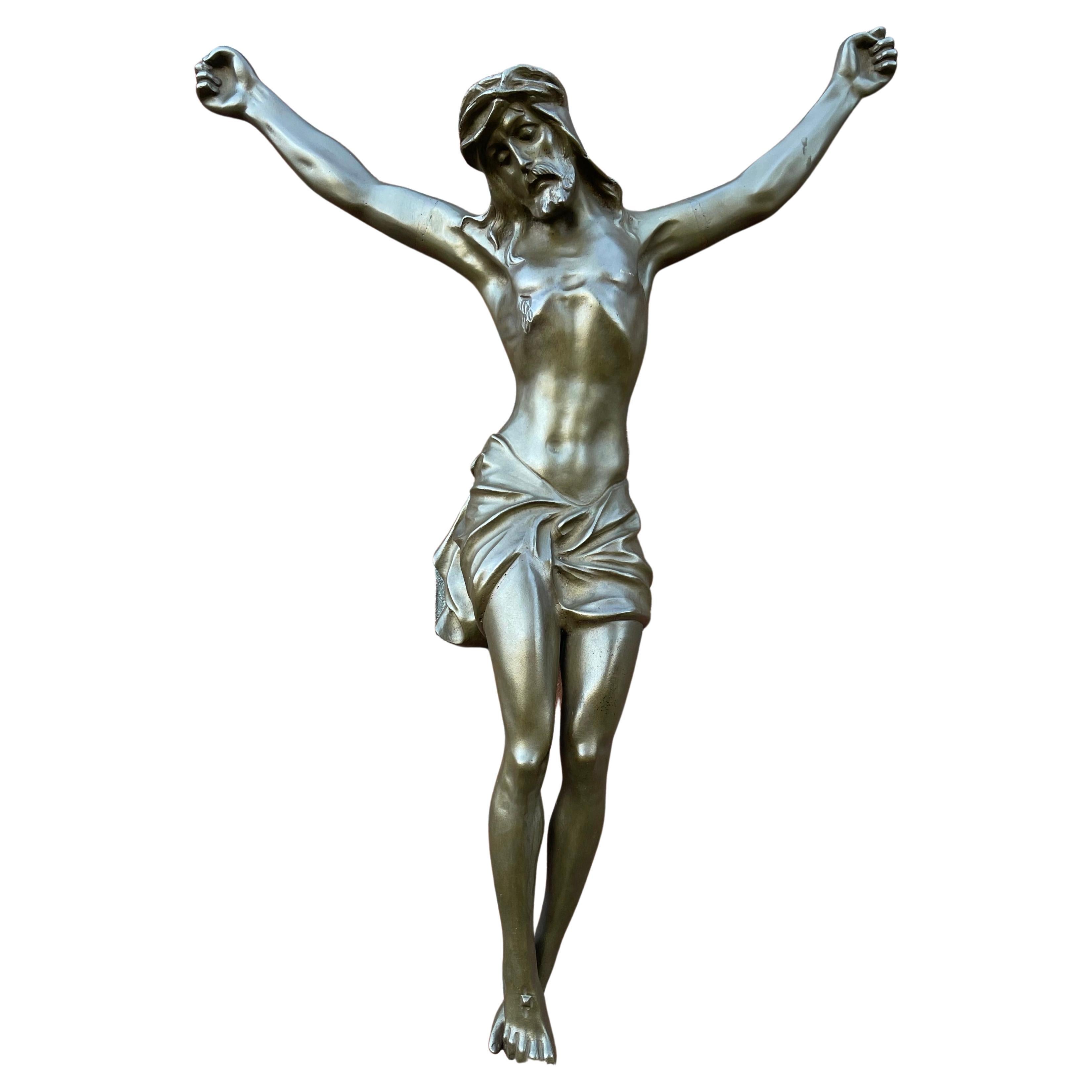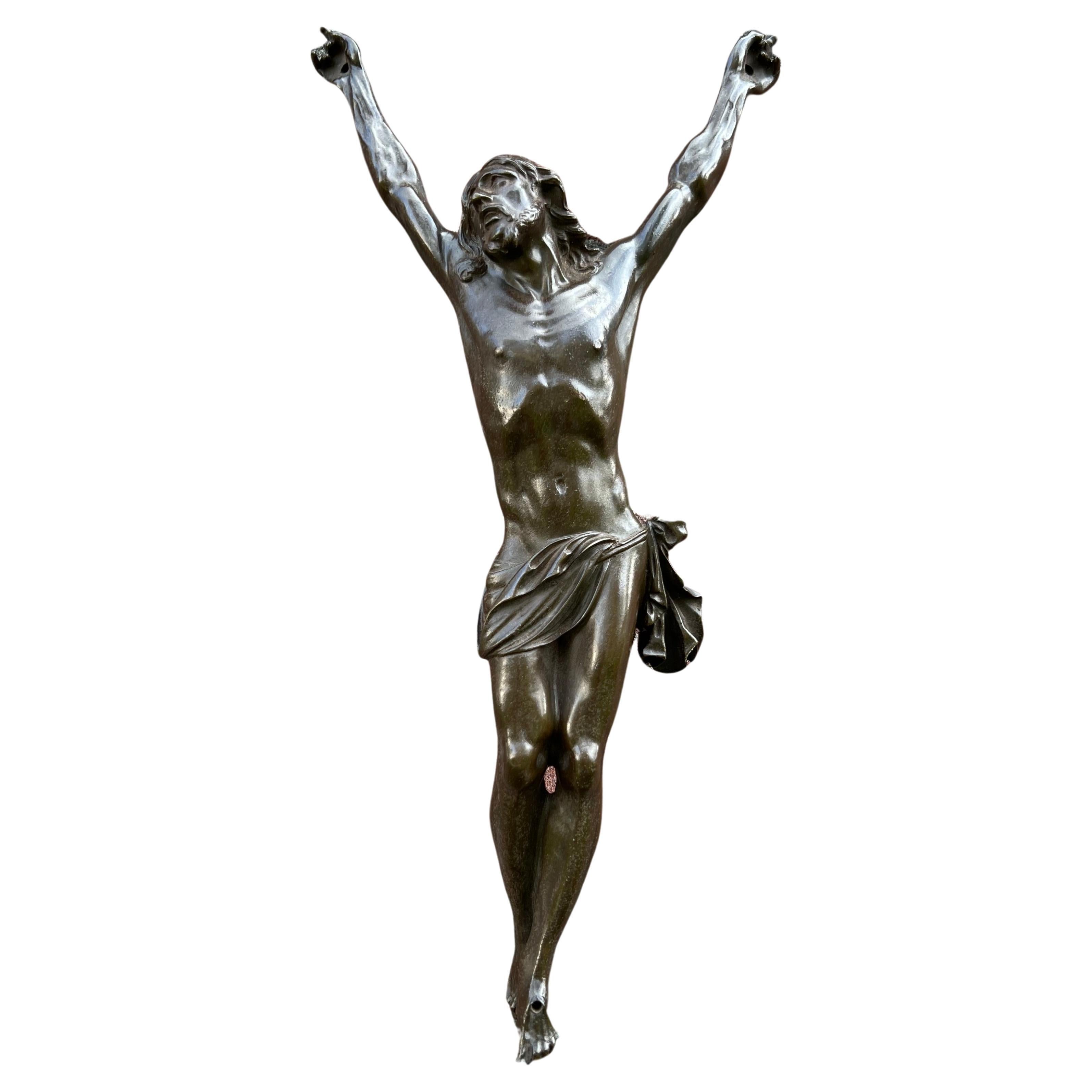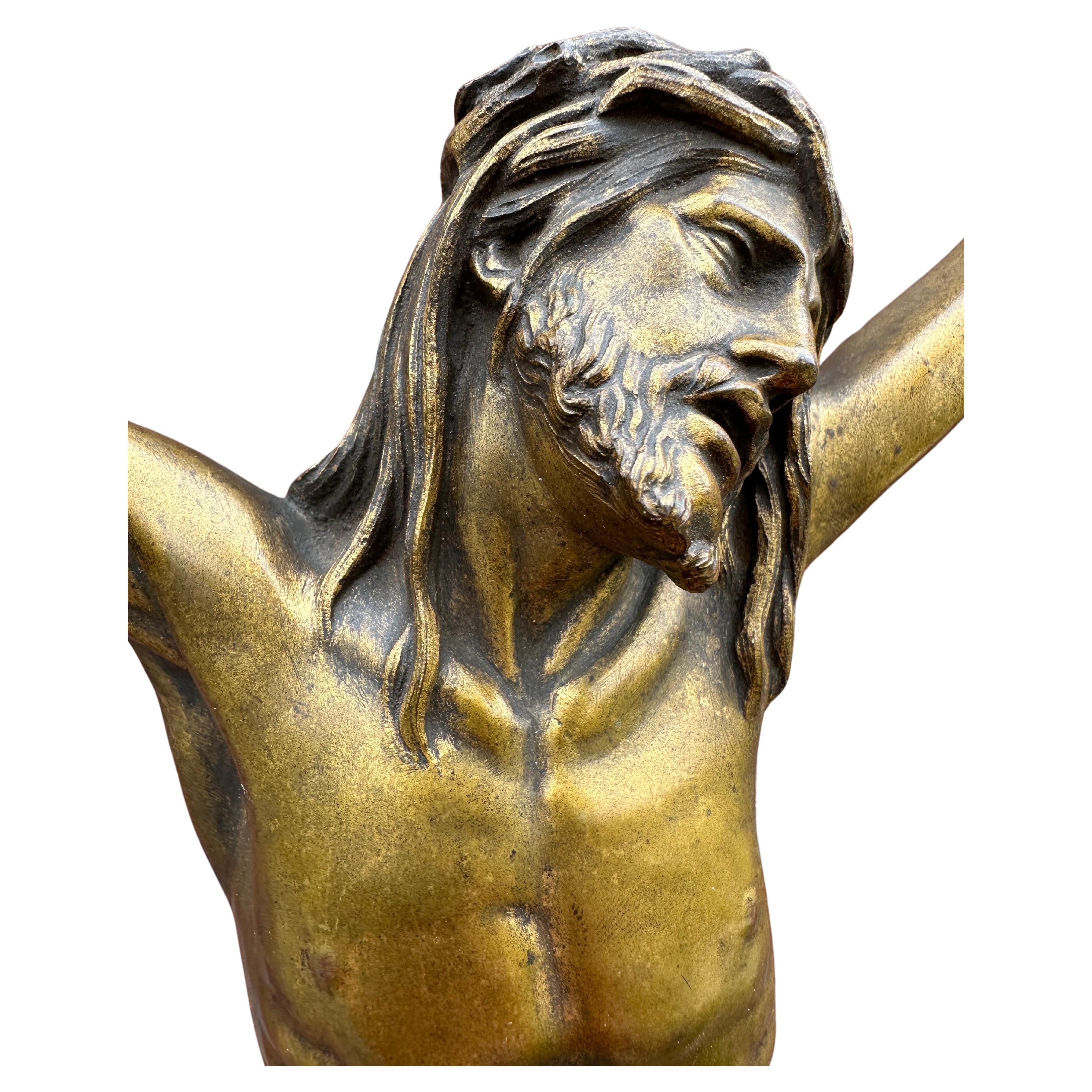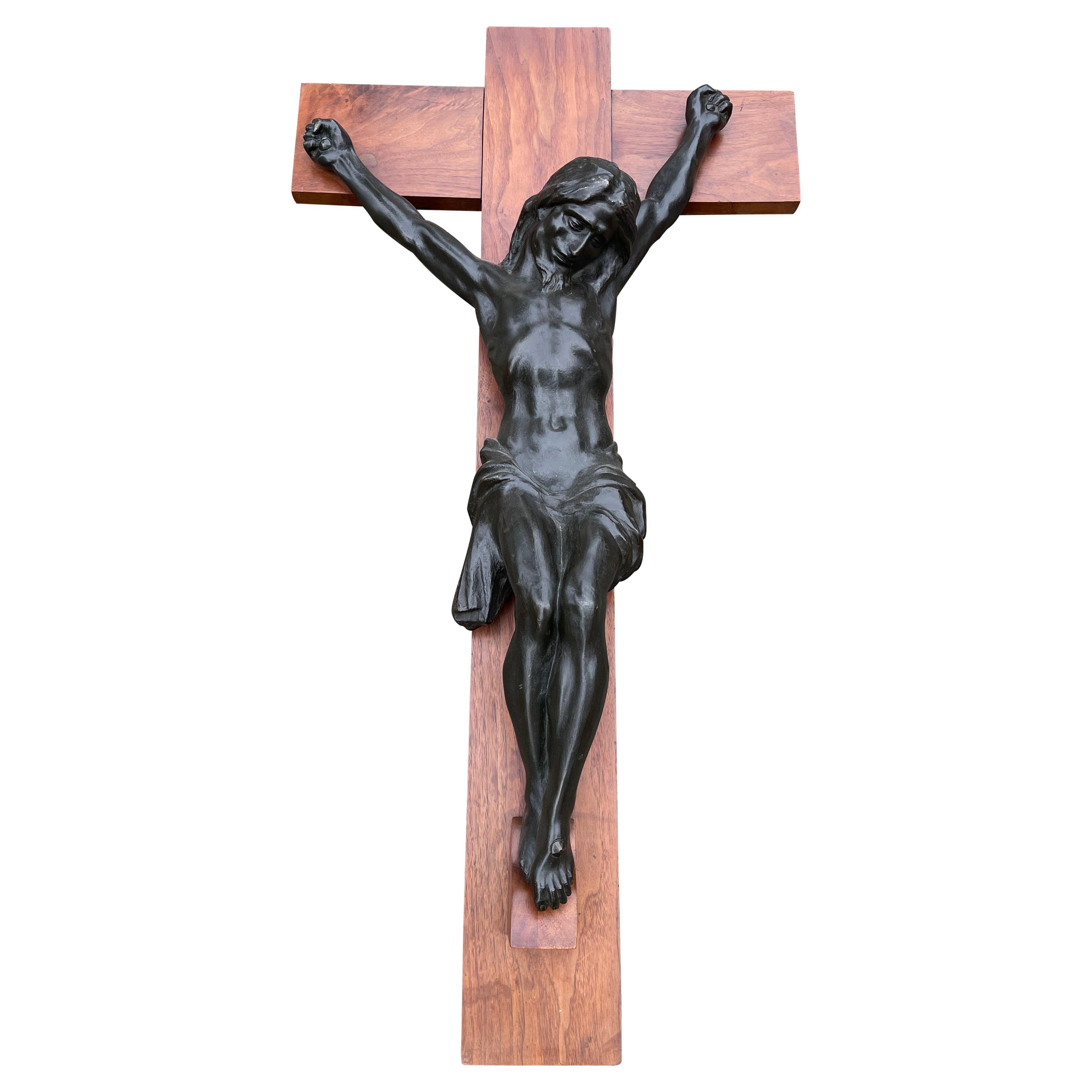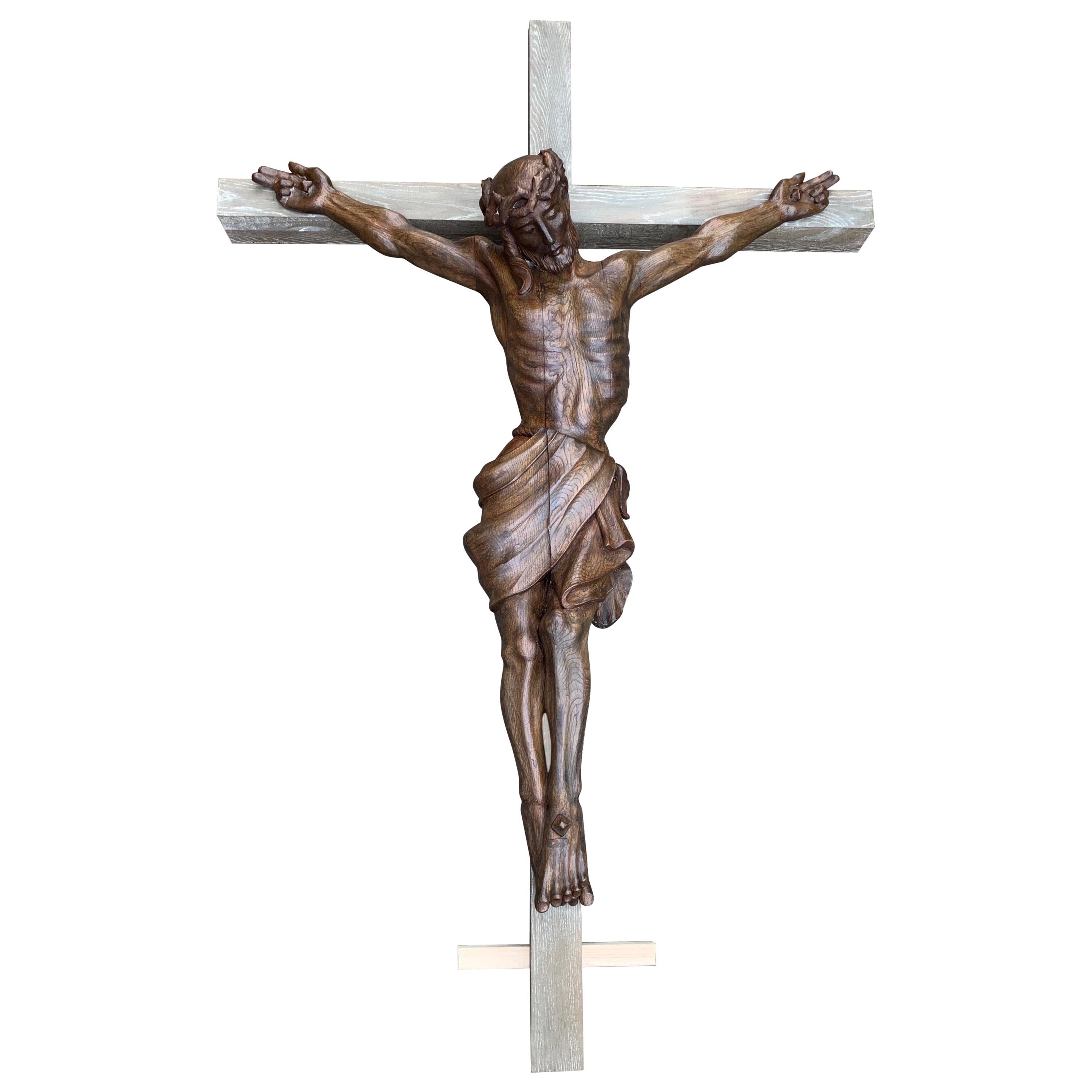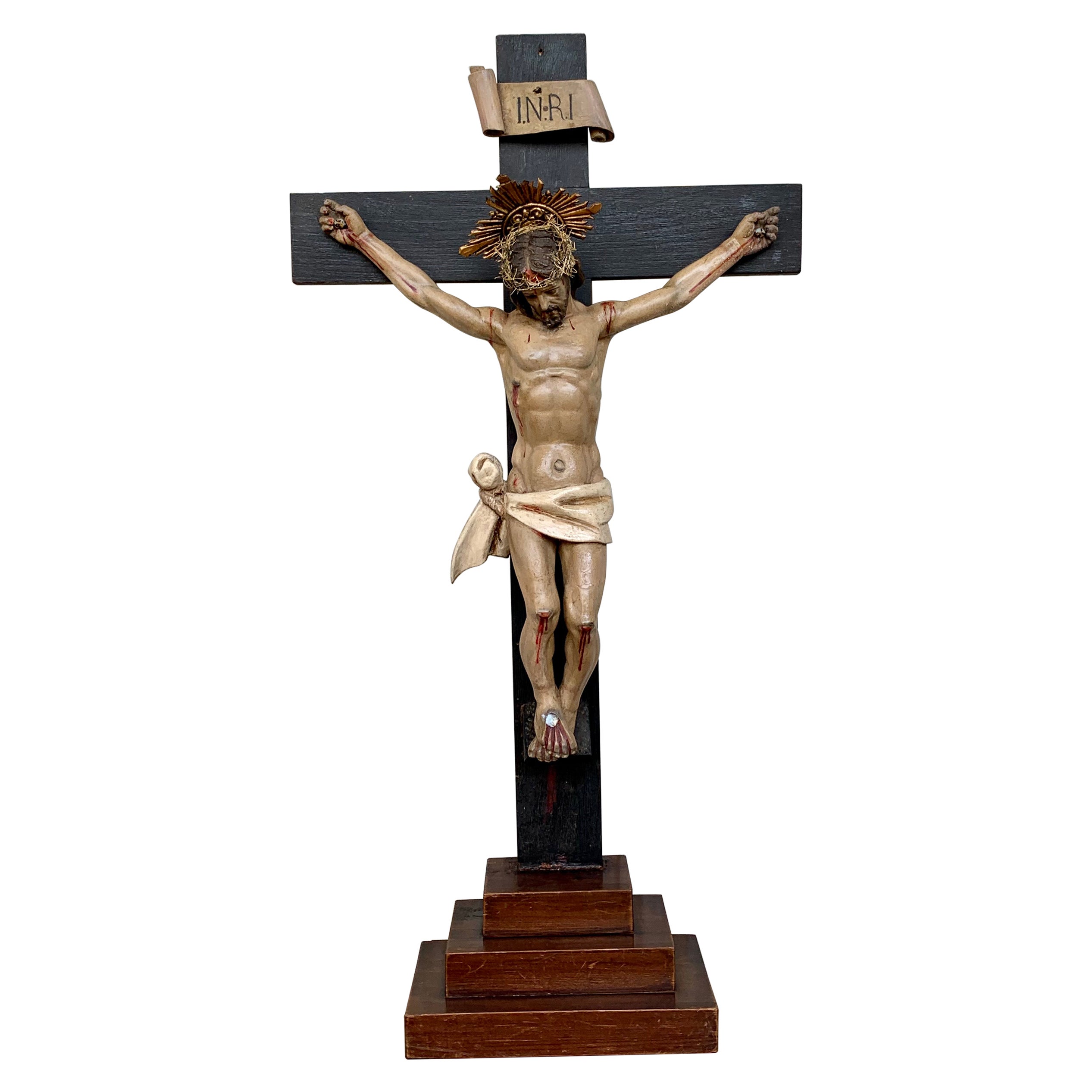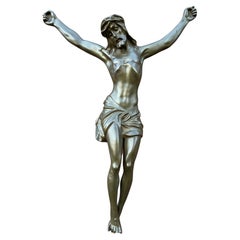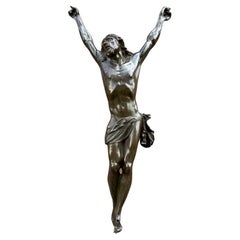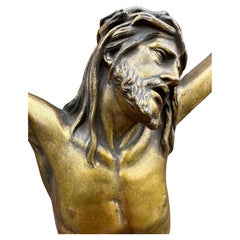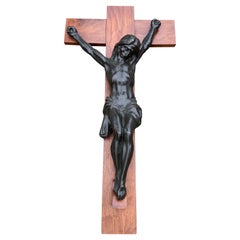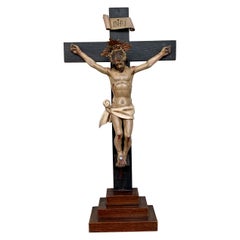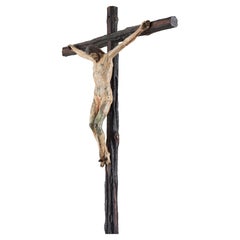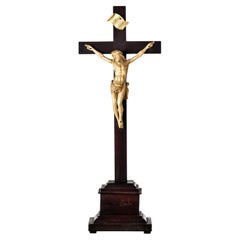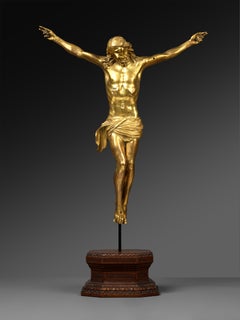Items Similar to Extra Large Antique and Great Quality Bronze Corpus of Christ w. Amazing Patina
Want more images or videos?
Request additional images or videos from the seller
1 of 20
Extra Large Antique and Great Quality Bronze Corpus of Christ w. Amazing Patina
$5,636.14
£4,192.72
€4,700
CA$7,717.80
A$8,581.15
CHF 4,480.60
MX$104,453.47
NOK 57,170.53
SEK 53,566.06
DKK 35,778.50
Shipping
Retrieving quote...The 1stDibs Promise:
Authenticity Guarantee,
Money-Back Guarantee,
24-Hour Cancellation
About the Item
One of a kind, large and beautifully handcrafted, work of religious art.
An antique bronze crucifix corpus of this size is a rare find and to have been given the opportunity to purchase one of such beautiful quality and details more than made our day. The striking anatomy and the unique patina of this large wall sculpture of our Lord Jesus are truly marvelous and we could see this antique go to private collectors / worshippers, but also to a church or monastery. A corpus of this size can also be seen in detail from a larger distance which makes it also suitable for mounting higher up on your wall, leaving a lasting impression. Given its age, large size and finest patina, we are proud to be able to present it to you on 1stdibs in such great condition.
So if you are looking for a unique and aesthetically pleasing Christ sculpture to grace your house of worship or home shrine then this meaningful work of religious art could be perfect for you. Mind you, our price for this one of a kind antique also includes perfect packing and even free delivery from our store to your door in just 4 to 6 days. No matter where you may live on our beautiful planet.
Maximum height x width x depth: 34.5 x 25.8 x 6.4 inches.
Height head till toes: 31.6 icnches.
Weight: 16.5 kilogram or 36.6 pounds lbs.
We have a passion for the unique, for quality, for stylish and meaningful and for craftsmanship of years gone by. Your purchases will be extremely well packaged and we look forward to serving you (again).
You can shop all our 1000+ listings by pushing the button that reads 'View All From Seller'.
- Dimensions:Height: 34.5 in (87.63 cm)Width: 25.8 in (65.54 cm)Depth: 6.4 in (16.26 cm)
- Style:Gothic Revival (Of the Period)
- Materials and Techniques:
- Place of Origin:
- Period:
- Date of Manufacture:1900-1920
- Condition:Wear consistent with age and use. Please also read our item description.
- Seller Location:Lisse, NL
- Reference Number:Seller: Hw022686610-USfg Free Shipping 1stDibs: LU2341331674772
About the Seller
5.0
Platinum Seller
Premium sellers with a 4.7+ rating and 24-hour response times
Established in 2000
1stDibs seller since 2016
2,943 sales on 1stDibs
Typical response time: 1 hour
- ShippingRetrieving quote...Shipping from: Lisse, Netherlands
- Return Policy
Authenticity Guarantee
In the unlikely event there’s an issue with an item’s authenticity, contact us within 1 year for a full refund. DetailsMoney-Back Guarantee
If your item is not as described, is damaged in transit, or does not arrive, contact us within 7 days for a full refund. Details24-Hour Cancellation
You have a 24-hour grace period in which to reconsider your purchase, with no questions asked.Vetted Professional Sellers
Our world-class sellers must adhere to strict standards for service and quality, maintaining the integrity of our listings.Price-Match Guarantee
If you find that a seller listed the same item for a lower price elsewhere, we’ll match it.Trusted Global Delivery
Our best-in-class carrier network provides specialized shipping options worldwide, including custom delivery.More From This Seller
View AllLarge & Impressive Antique Bronze Corpus of Christ w. Amazing Details and Patina
Located in Lisse, NL
Stunning and beautifully handcrafted, work of religious art.
Large bronze crucifixes are a rare find and to have been given the opportunity to purchase one of such beautiful quality and details made us grateful. The well portrait anatomy and the perfect patination of this large Christ sculpture are truly marvelous and we could see this antique go to both private collectors/worshippers and to a church or monastery. Mounted on the wall this rare size corpus will make a lasting impression, also from further away. So if you are looking for a unique and aesthetically pleasing Christ sculpture to grace your house of worship or home shrine then this meaningful Christian relic...
Category
Antique Late 19th Century German Gothic Revival Religious Items
Materials
Bronze
Finest Detailed and Patina Antique Bronze Corpus of Christ for Wall Mounting
Located in Lisse, NL
Beautiful and meaningful religious art.
If only the best quality and condition is good enough for you then this stunning and practical size corpus of Christ could be gracing your wall soon. Both the perfect anatomy and the amazing details in this antique corpus...
Category
Antique 1790s Italian Renaissance Revival Religious Items
Materials
Bronze
Museum Quality Hand Crafted Bronze Corpus of Jesus Christ fr Wall Mounting 19thC
Located in Lisse, NL
Stunning, one of a kind bronze corpus of Christ.
The meaning of this antique sculpture obviously needs no explanation. However, not everybody looks at the corpus of Christ with the same ideas and emotions. And each individual may also have different emotions and ideas depending on his or her state of mind at a certain moment in the day or at a certain time in his or her life. Besides that, every artist/sculptor may also have his or her own ideas of what he or she is trying to express and communicate. What is important to us, is that a work of religious art speaks to us. If it speaks to us then almost always there will also be someone else who sees the beauty, deeper meaning, quality, style and uniqueness. This particular corpus stands out for its exceptional physical details and its painful facial features. We also rarely seen an antique Christ sculpture...
Category
Antique 19th Century European Renaissance Revival Religious Items
Materials
Bronze
Large & Impressive & Rare Bronze Corpus of Christ Crucifix by Jef Lambeaux
By Jef Lambeaux
Located in Lisse, NL
Stunning and beautifully handcrafted, work of religious art, by sculptor Jef Lambeaux with mazing details and patina
Large bronze crucifixes are a rare find and to have been given the opportunity to purchase one of such beautiful quality and details more than made our day. The striking anatomy and the unique patina of this large Christ sculpture are truly marvelous and we could see this antique go...
Category
Antique Late 19th Century Belgian Gothic Revival Religious Items
Materials
Bronze
Extra Large Crucifix with Hand Carved Oak Corpus of Christ for Church or Chapel
Located in Lisse, NL
Beautifully carved and large size corpus of Jesus, made in the Arts & Crafts era.
This meaningful and unique crucifix from the early 1900s comes with a larger than life, hand carved oak Corpus of Christ. The details in the anatomy of this Christ are very well carved and they clearly reveal the suffering and dehydration that His body endured in the final days of his life. The artist/sculptor is clearly showing us the image of Jesus when or right after he bowed his head and died. The solid oak cross is original to this corpus and it was given a different color so that the unique and impressive corpus stands out perfectly. Have you also noticed the perfectly carved and thick crown of thorns on the head of Christ. The patina of this excellent condition and large corpus is another great feature that will never fail to impress. The former owners gave us the photo that you see in image 3 in this listing and in it you can see where this antique corpus...
Category
Early 20th Century European Arts and Crafts Religious Items
Materials
Oak
Stunning & Powerful Altar Crucifix with Detailed Bronze Sculpture of Christ 1912
Located in Lisse, NL
Unique table crucifix and a wonderful work of religious art, dated 1912 and numbered.
For us the most powerful statement will always be 'the truth will set you free'. It is what we have learned most from the life of Christ and of His teachings and it is the one thing we always think about whenever we look at a crucifix. Anyone who has tried to break down his/her ego and found a clearer consciousness in the process knows how healing and rewarding that journey can be. After that you can only be grateful for all the good things that are bound to come your way. Good things will come your way, because the universe needs people like you. Whomever created this amazing work of religious art too must have been inspired and motivated by the life of Christ, because how ever could anyone create a piece that is of such quality, so beautiful and so powerful at the same time. Both the beautifully designed bronze cross with the King of the Jews inscription and the amazingly detailed bronze corpus of Christ are of a quality that you will only rarely find on the open market. They are perfectly mounted on a stunning marble base and together they create one of the most impressive table or altar crucifixes...
Category
Early 20th Century European Gothic Revival Religious Items
Materials
Marble, Bronze
You May Also Like
Art Decò Hand Carved Wooden Crucifix with Stunning Bronze Corpus of Christ
Located in Miami, FL
Crucifix from the mid-1800s with a carved shroud or veil depicting Christ in the base. This unique and remarkable antique crucifix can both be used as a table and as a wall crucifix. Over the decades we have sold a number of unique and very well crafted crucifixes, but never one in the Art Decò style with this combination of materials and techniques. The overall design and size is what stands out first, but the details and the materials are what make this antique work of religious art extraordinary. The relatively large base of this unique crucifix is a work of religious art in its own right. It is almost as if the cross is growing from this beautiful base and the cross itself too comes with a number of superbly inlays details. With their symbolic meaning of birth and resurrection it is obvious why the artist / sculptor so tastefully incorporated them here. Apart from a minor 'lean' to the left, the cross itself too is in excellent condition. If one were to speak of a trinity in this crucifix then the unique base and cross are completed with an equally striking, solid bronze corpus of Christ...
Category
Mid-20th Century European Art Deco Religious Items
Materials
Bronze
Rare and important painted bronze Crucifix after a model by Michelangelo
By Michelangelo Buonarroti
Located in Leesburg, VA
A rare and very fine bronze corpus of Christ after a model by Michelangelo, cast ca. 1597-1600 by Juan Bautista Franconio and painted in 1600 by Francisco Pacheco in Seville, Spain.
The present corpus reproduces a model attributed to Michelangelo. The best known example, lesser in quality, is one on display at the Metropolitan Museum of Art (MET).
The association of this corpus with Michelangelo was first brought to light by Manuel Gomez-Moreno (1930-33) who studied the wider circulated casts identified throughout Spain. The attribution to Michelangelo was subsequently followed by John Goldsmith-Phillips (1937) of the MET and again by Michelangelo expert, Charles de Tolnay (1960).
While Michelangelo is best known for his monumental works, there are four documented crucifixes he made. The best known example is the large-scale wooden crucifix for the Church of Santa Maria del Santo Spirito in Florence, made in 1492 as a gift for the Prior, Giovanni di Lap Bicchiellini, for allowing him to study the anatomy of corpses at the hospital there. In 1562, Michelangelo wrote two letters to his nephew, Lionardo, indicating his intention to carve a wooden crucifix for him. In 1563 a letter between Lionardo and the Italian sculptor Tiberio Calcagni, mentions this same crucifix (a sketch of a corpus on the verso of a sheet depicting Michelangelo’s designs for St. Peter’s Basillica [Palais des Beaux-Arts in Lille] may reproduce this). That Michelangelo was working on small corpora in the last years of his life is further evidenced by the small (26.5 cm) unfinished wooden crucifix located at the Casa Buonarroti, considered his last known sculptural undertaking. Michelangelo’s contemporary biographer, Giorgio Vasari additionally cites that Michelangelo, in his later years, made a small crucifix for his friend, Menighella, as a gift.
Surviving sketches also indicate Michelangelo’s study of this subject throughout his career, most notably during the end of his life but also during the 1530s-40s as he deepened his spiritual roots. The occasional cameo of crucified Christ’s throughout his sketched oeuvre have made it challenging for scholars to link such sketches to any documented commissions of importance. All the while, in consideration that such objects were made as gifts, it is unlikely they should be linked with commissions.
Nonetheless, a number of theories concerning Michelangelo’s sketches of Christ crucified have been proposed and some may regard the origin of the present sculpture. It has been suggested that the corpus could have its impetus with Michelangelo’s work on the Medici Chapel, whose exclusive design was given to the master. It is sensible smaller details, like an altar cross, could have fallen under his responsibility (see for example British Museum, Inv. 1859,0625.552). Others have noted the possibility of an unrealized large marble Crucifixion group which never came to fruition but whose marble blocks had been measured according to a sheet at the Casa Buonarroti.
A unique suggestion is that Michelangelo could have made the crucifix for Vittoria Colonna, of whom he was exceedingly fond and with whom he exchanged gifts along with mutual spiritual proclivities. In particular, Vittoria had an interest in the life of St. Bridget, whose vision of Christ closely resembles our sculpture, most notably with Christ’s proper-left leg and foot crossed over his right, an iconography that is incredibly scarce for crucifixes. The suggestion could add sense to Benedetto Varchi’s comment that Michelangelo made a sculpted “nude Christ…he gave to the most divine Marchesa of Pescara (Vittoria Colonna).”
Of that same period, two sketches can be visually linked to our sculpture. Tolnay relates it to a sketch of a Crucified Christ at the Teylers Museum (Inv. A034) of which Paul Joannides comments on its quality as suggestive of preparations for a sculptural work. Joannides also calls attention to a related drawing attributed to Raffaello da Montelupo copying what is believed to be a lost sketch by Michelangelo. Its relationship with our sculpture is apparent. Montelupo, a pupil of Michelangelo’s, returned to Rome to serve him in 1541, assisting with the continued work on the tomb of Pope Julius II, suggesting again an origin for the corpus ca. 1540.
The earliest firm date that can be given to the present corpus is 1574 where it appears as a rather crudely conceived Crucifixion panel, flanked by two mourners in low-relief and integrally cast for use as the bronze tabernacle door to a ciborium now located at the Church of San Lorenzo in Padula. Etched in wax residue on the back of the door is the date, 27 January 1574, indicating the corpus would have at least been available as a model by late 1573.
The Padula tabernacle was completed by Michelangelo’s assistant, Jacopo del Duca and likely has its origins with Michelangelo’s uncompleted tabernacle for the Basilica of St. Mary of the Angels in Rome.
The impetus for the Padula tabernacle’s Crucifixion panel begins with a series of late Crucifixion sketches by Michelangelo, depicting a scene of Christ crucified and flanked by two mourners (see British Museum Inv. 1895.0915.510; Ashmolean Museum Inv. 1846.89, KP II 343 recto; Windsor Castle RCIN 912761 recto; and Louvre Inv. 700). A faintly traced block possibly intended for sculpting the sketch of the crucified Christ on its recto was discovered by Tolnay on a version of the composition at Windsor Castle. The Windsor sketch and those related to it appear to have served as preparatory designs for what was probably intended to become the Basilica of St. Mary’s tabernacle door. Vasari documents that the project was to be designed by Michelangelo and cast by his assistant, Jacopo del Duca. Michelangelo died before the commission was complete, though on 15 March 1565, Jacopo writes to Michelangelo’s nephew stating, “I have started making the bronze tabernacle, depending on the model of his that was in Rome, already almost half complete.” Various circumstances interrupted the completion of the tabernacle, though its concept is later revitalized by Jacopo during preparations to sell a tabernacle, after Michelangelo’s designs, to Spain for Madrid’s El Escorial almost a decade later. The El Escorial tabernacle likewise encountered problems and was aborted but Jacopo successfully sold it shortly thereafter to the Carthusians of Padula.
An etched date, 30 May 1572, along the base of the Padula tabernacle indicates its framework was already cast by then. A 1573 summary of the tabernacle also describes the original format for the door and relief panels, intended to be square in dimension. However, a last minute decision to heighten them was abruptly made during Jacopo’s negotiations to sell the tabernacle to King Phillip II of Spain. Shortly thereafter the commission was aborted. Philippe Malgouyres notes that the Padula tabernacle’s final state is a mixed product of the original design intended for Spain’s El Escorial, recycling various parts that had already been cast and adding new quickly finished elements for its sale to Padula, explaining its unusually discordant quality, particularly as concerns the crudeness of the door and relief panels which were clearly made later (by January 1574).
Apart from his own admission in letters to Spain, it is apparent, however, that Jacopo relied upon his deceased master’s designs while hastily realizing the Padula panels. If Michelangelo had already earlier conceived a crucifix model, and Jacopo had access to that model, its logical he could have hastily employed it for incorporation on the door panel to the tabernacle. It is worth noting some modifications he made to the model, extending Christ’s arms further up in order to fit them into the scale of the panel and further lowering his chin to his chest in order to instill physiognomic congruence. A crude panel of the Deposition also follows after Michelangelo’s late sketches and is likewise known by examples thought to be modifications by Jacopo based upon Michelangelo’s initial sculptural conception (see Malgouyres: La Deposition du Christ de Jacopo del Duca, chef-d’oeuvre posthume de Michel-Ange).
Jacopo’s appropriation of an original model by Michelangelo for more than one relief on the Padula tabernacle adds further indication that the crucifix was not an object unique to Jacopo’s hand, as few scholars have posited, but rather belongs to Michelangelo’s original...
Category
Antique 16th Century Renaissance Figurative Sculptures
Materials
Bronze
JESUS CHRIST CRUCIFIED 19th Century Italian Sculpture
Located in Madrid, ES
JESUS CHRIST CRUCIFIED
19th Century Italian Sculpture
in ivor... Christ and table in carved ivory. Cross in Brazilian rosewood, carved...
Category
Antique 19th Century Italian Baroque Religious Items
Materials
Wood
GILT BRONZE FIGURE OF CRISTO MORTO ATTR. G DELLA PORTA, ITALIAN RENAISSANCE
Located in Milan, IT
Circle of Guglielmo Della Porta
(Porlezza, 1515 circa – Rome 1577)
CRISTO MORTO, Italy, mid 16th Century
Gilt bronze
54 x 48 cm
21 1/4 x 19 in
Provenance:
M. Barbagli Private Collec...
Category
16th Century Figurative Sculptures
Materials
Bronze
Christ in Bronze, Late 19th Century
Located in Marseille, FR
Bronze christ 1880 golden patina. Dimension height 20 cm for a width of 16 cm and a depth of 10 cm.
Additional information:
Material: Bronze.
Category
Antique 19th Century Figurative Sculptures
Materials
Bronze
Large Cross With Christ In Gilt Bronze From The 17th Century
Located in Madrid, ES
Large Cross With Christ In Gilt Bronze From The 17th Century
IMPORTANT 17th C. CROSS TO CHRIST IN FINELY CHISELLED GOLD BRONZE FRENCH SCHOOL OF THE...
Category
Antique 17th Century Religious Items
Materials
Bronze
$2,398 Sale Price
20% Off
